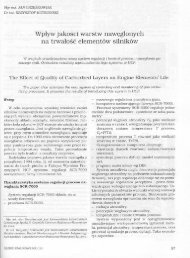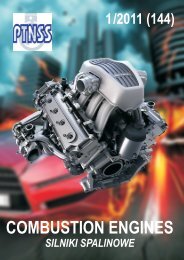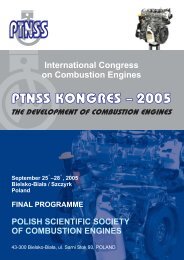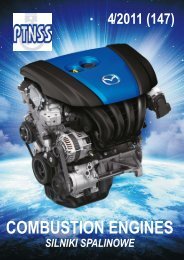Create successful ePaper yourself
Turn your PDF publications into a flip-book with our unique Google optimized e-Paper software.
Badania modelowe wtrysku benzyny i paliwa E85 do przewodu dolotowego silnika<br />
Modeling of physical phenomena occurring in a diesel<br />
engine is today very common [2 – 4]. Solving complex<br />
problems is possible thanks to a technique referred to as<br />
numerical fluid mechanics. By discretization of the analyzed<br />
volume and division into cells of infinite volume and thanks<br />
to the numerical solution of partial differential equations<br />
it is possible to determine approximate values of pressure<br />
gradients, temperatures or flow speeds of compressive factor.<br />
Most of the contemporary CFD programs are based<br />
on Navier-Stokes’ equations describing the principle of<br />
behavior of mass, momentum and energy of a moving fluid<br />
and, then discretizing the same using the method of finite<br />
elements, finite volumes of finite differences. The use of the<br />
software also enables conducting simulation tests of flows,<br />
in which chemical reactions or combustion processes occur,<br />
flows through porous structures, flows of Newton’s fluids<br />
or non-Newton’s fluids and simulation of fluid structure<br />
interaction.<br />
2. The model of intake pipe<br />
The model of intake pipe was developed in Workflow<br />
Manager module of AVL FIRE program. The model is<br />
composed of an intake pipe model and an injector model.<br />
The diameter of the intake pipe and the injector dimensions<br />
were determined based on the measurements of an actual<br />
object. In order to eliminate discontinuity in geometry and<br />
ensure the required accuracy of calculations, the correctness<br />
of the developed grid was verified. A cell type referred to<br />
as Hexahedron was used for the construction of the model.<br />
Finally, the model included 31500 cells (Fig. 1). This level<br />
of geometrical discretization ensured the required accuracy<br />
of calculations and simultaneous shortening of the period<br />
of calculations.<br />
Fig. 1. The calculation grid of the tested intake pipe<br />
Rys. 1. Siatka obliczeniowa badanego przewodu dolotowego<br />
Due to the occurrence of a violent flow, it was necessary<br />
to define an appropriate model of turbulence. The k-zeta-f<br />
model was used for turbulent flows. This choice was determined<br />
by analysis of the literature related to simulation<br />
tests [1]. AVL FIRE Wall Film model was also used for the<br />
determination of the distribution of fuel in the intake pipe and<br />
the determination of the intensity of evaporation of the fuel<br />
from the film. The calculations were performed with the assumption<br />
of a model of density of an ideal gas, where density<br />
was determined by the function of pressure and temperature.<br />
The flow of fluid was defined as a compressive flow.<br />
wpływ paliwa alkoholowego na intensywność powstawania<br />
filmu paliwowego w zależności od prędkości obrotowej<br />
silnika oraz ciśnienia w przewodzie dolotowym. Analizowano<br />
rozkład i grubość filmu paliwowego w przewodzie<br />
dolotowym silnika.<br />
Modelowanie zjawisk fizycznych, jakie zachodzą w silniku<br />
spalinowym jest obecnie bardzo rozpowszechnione [2 –<br />
4]. Rozwiązywanie złożonych zagadnień możliwe jest dzięki<br />
technice określanej jako numeryczna mechanika płynów.<br />
Przez dyskretyzację analizowanej objętości oraz podział<br />
na komórki o skończonej objętości i dzięki numerycznemu<br />
rozwiązaniu cząstkowych równań różniczkowych możliwe<br />
jest przybliżone wyznaczenie gradientów ciśnień, temperatur<br />
lub prędkości przepływu czynnika ściśliwego. Większość<br />
współczesnych programów CFD bazuje na równaniach Naviera-Stokesa,<br />
opisujących zasadę zachowania masy, pędu i<br />
energii dla poruszającego się płynu, a następnie dyskretyzuje<br />
je za pomocą metody elementów skończonych, metody<br />
objętości skończonych lub metody różnic skończonych.<br />
Zastosowane oprogramowanie umożliwia także prowadzenie<br />
badań symulacyjnych przepływów, w których występują<br />
reakcje chemiczne lub procesy spalania, przepływów przez<br />
struktury porowate, przepływów płynów newtonowskich<br />
lub nienewtonowskich oraz symulację interakcji płyn–ciało<br />
stałe (Fluid Structure Interaction).<br />
2. Model przewodu dolotowego<br />
Model przewodu dolotowego opracowano w module<br />
Workflow Manager programu AVL FIRE. Model złożony<br />
jest z modelu przewodu dolotowego oraz z modelu wtryskiwacza.<br />
Średnicę przewodu dolotowego oraz wymiary<br />
wtryskiwacza określono na podstawie pomiarów rzeczywistego<br />
obiektu badawczego. W celu wyeliminowania<br />
nieciągłości w geometrii oraz zapewnienia<br />
wymaganej dokładności obliczeń wykonano<br />
weryfikację poprawności opracowanej siatki.<br />
Do budowy modelu zastosowano jeden typ<br />
komórki o nazwie Hexahedron. Ostatecznie<br />
model składał się z 31 500 komórek (rys. 1).<br />
Taki poziom dyskretyzacji geometrycznej zapewnił<br />
wymaganą dokładność obliczeń przy<br />
jednoczesnym skróceniu czasu obliczeń.<br />
Z uwagi na występowanie przepływu<br />
burzliwego niezbędne było zdefiniowanie<br />
odpowiedniego modelu turbulencji. Podczas<br />
obliczeń zastosowano model k-zeta-f dla<br />
przepływów turbulentnych. Wybór ten był<br />
podyktowany analizą literatury dotyczącej badań symulacyjnych<br />
[1]. Zastosowano także moduł AVL FIRE Wall Film<br />
do określenia rozkładu paliwa w przewodzie dolotowym<br />
oraz określenia intensywności parowania paliwa z filmu.<br />
Obliczenia prowadzono przy założeniu modelu gęstości gazu<br />
idealnego, gdzie gęstość została określona funkcją ciśnienia<br />
i temperatury. Przepływ płynu zdefiniowano jako ściśliwy.<br />
Warunki początkowe dla powietrza:<br />
– gęstość w warunkach normalnych 1,19 kg/m 3 ,<br />
– temperatura 30 o C,<br />
– energia kinetyczna turbulencji 0,5 m 2 /s 2 ,<br />
56 <strong>COMBUSTION</strong> <strong>ENGINES</strong>, No. 4/2012 (151)












